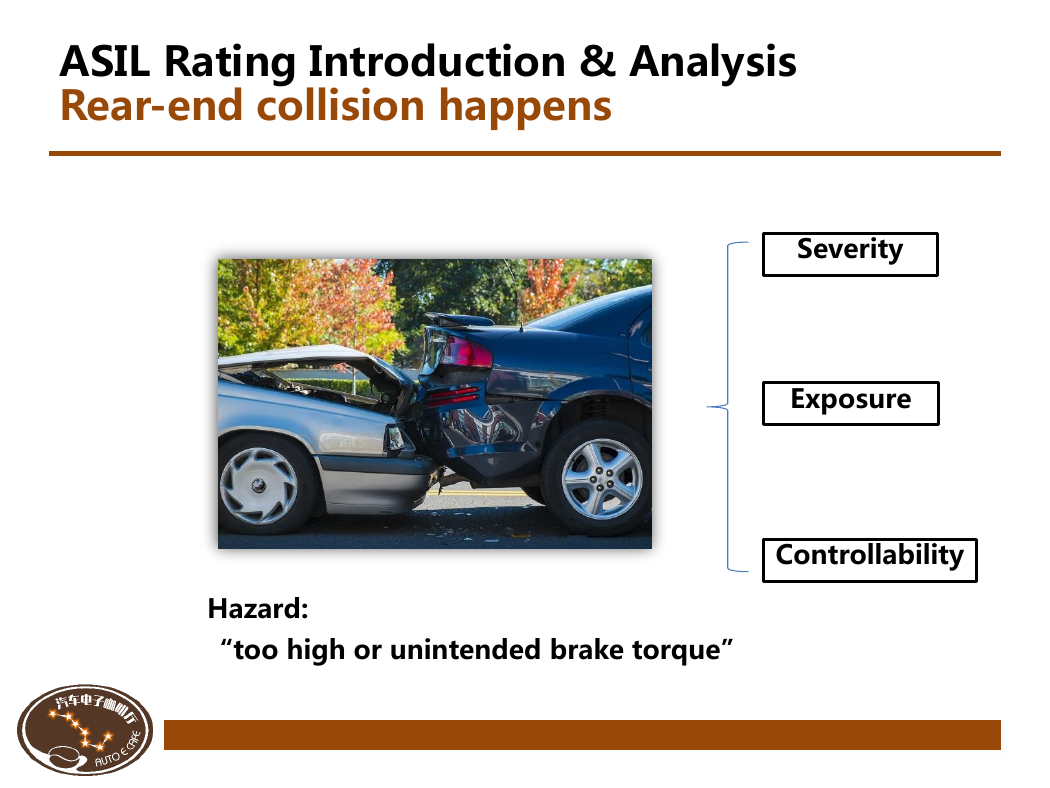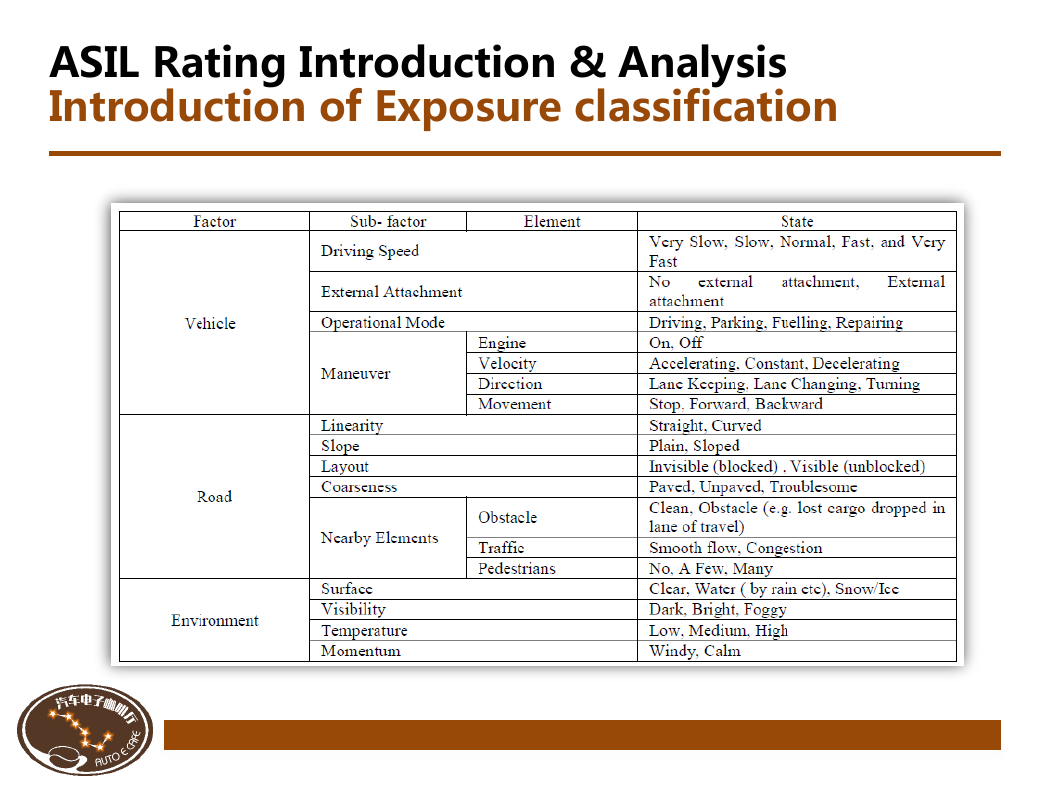ASIL Rating Introduction & Analysis
Functional Safety - ISO 26262: 2011
Functional Safety*
absence of unreasonable risk due to hazards caused by malfunctioning
behavior of E/E systems
The complete product life cycle is addressed
system-description
hazard analysis
system development
HW- and SW-development
production
service
decommissioning
�
ASIL Rating Introduction & Analysis
Functional Safety - ISO 26262: 2011
Concept Phase
Development
Phase
Start of
Production and
Operation
System
development
HW & SW
development
Functional Safety Management Activities
Functional Safety Management concerns all engineering phases!
�
ASIL Rating Introduction & Analysis
Rear-end collision happens
Severity
Exposure
Controllability
Hazard:
“too high or unintended brake torque”
�
ASIL Rating Introduction & Analysis
Introduction of severity classification
AIS0
no injuries
AIS1
Light injuries
AIS2 moderate
injuries
AIS3
severe but not life-
threatening injuries
AIS4
AIS5
severe injuries (life-
threatening, survival
probable)
critical injuries
(life-threatening,
survival uncertain)
AIS6
extremely critical
or fatal injuries
Abbreviated Injury Scale
AIS
Severity
skin-deep wounds(皮肤擦伤)
up to 15 minutes of unconsciousness(短暂失去意识)
Skull fractures without brain injury(骨折)
concussion with or without skull fractures with up to 12 hours of unconsciousness
(颅骨受伤导致的长时间昏迷)
more than 12 hours of unconsciousness including intracranial bleeding
(12小时以上昏迷且颅内出血)
as fractures of the cervical vertebrae above the third cervical vertebra
with damage to the spinal cord
(致命伤害)
�
ASIL Rating Introduction & Analysis
Introduction of severity classification
S0
Damage that cannot be
classified safety-related
S1
More than 10 % probability of
AIS 1-6 (and not S2 or S3)
S2
More than 10 % probability
of AIS 3-6 (and not S3)
S3
More than 10 %
probability of AIS 5-6
�
ASIL Rating Introduction & Analysis
Introduction of Exposure classification
�
ASIL Rating Introduction & Analysis
Introduction of Exposure classification
Duration
(% of average
operating time)
Not specified
<1 %
1 % to 10 %
>10 %
E1
E2
E3
E4
Road layout
Highway entrance
ramp
One-way street
(city street)
One-way street (city street)
Highway
Road surface
Nearby elements
obstacle in lane of
travel (highway)
Vehicle stationary
state
In repair garage
(on roller rig)
Manoeuvre
Driving downhill
with engine off
(mountain pass)
Snow and ice on
road
Nearing end of
congestion
(highway)
In repair garage
(during diagnosis
or repair)
Driving in reverse
(city street)
Wet road
Traffic congestion
Vehicle on a hill (hill hold)
Heavy traffic (stop and go)
Visibility
Unlighted roads at night
Accelerating
Decelerating
Executing a turn (steering)
Parking (parking lot)
Lane change (city street)
Stopping at traffic light (city street)
Lane change (highway)
�
ASIL Rating Introduction & Analysis
Introduction of Controllability classification
Controllable in general
99 % or more of all drivers or
other traffic participants are
usually able to avoid harm
90 % or more of all
drivers or other traffic
participants are usually
able to avoid harm
Less than 90 % of all drivers or
other traffic participants are
usually able, or barely able, to
avoid harm
Driving factors and
scenarios
C0
C1
C2
C3
Warning message - gas low
Maintain intended
driving path
Faulty adjustment of seat
position while driving
Failure of ABS during
emergency brakingents
Failure of ABS when braking
on low friction road surface
while executing a turn
Faulty driver airbag release
when travelling at high
speed
Brake to slow/stop vehicle
Maintain intended driving
path
Maintain intended driving path,
stay in lane
-Maintain intended driving
path, stay in lane
-Brake to slow/stop vehicle
�
















 2023年江西萍乡中考道德与法治真题及答案.doc
2023年江西萍乡中考道德与法治真题及答案.doc 2012年重庆南川中考生物真题及答案.doc
2012年重庆南川中考生物真题及答案.doc 2013年江西师范大学地理学综合及文艺理论基础考研真题.doc
2013年江西师范大学地理学综合及文艺理论基础考研真题.doc 2020年四川甘孜小升初语文真题及答案I卷.doc
2020年四川甘孜小升初语文真题及答案I卷.doc 2020年注册岩土工程师专业基础考试真题及答案.doc
2020年注册岩土工程师专业基础考试真题及答案.doc 2023-2024学年福建省厦门市九年级上学期数学月考试题及答案.doc
2023-2024学年福建省厦门市九年级上学期数学月考试题及答案.doc 2021-2022学年辽宁省沈阳市大东区九年级上学期语文期末试题及答案.doc
2021-2022学年辽宁省沈阳市大东区九年级上学期语文期末试题及答案.doc 2022-2023学年北京东城区初三第一学期物理期末试卷及答案.doc
2022-2023学年北京东城区初三第一学期物理期末试卷及答案.doc 2018上半年江西教师资格初中地理学科知识与教学能力真题及答案.doc
2018上半年江西教师资格初中地理学科知识与教学能力真题及答案.doc 2012年河北国家公务员申论考试真题及答案-省级.doc
2012年河北国家公务员申论考试真题及答案-省级.doc 2020-2021学年江苏省扬州市江都区邵樊片九年级上学期数学第一次质量检测试题及答案.doc
2020-2021学年江苏省扬州市江都区邵樊片九年级上学期数学第一次质量检测试题及答案.doc 2022下半年黑龙江教师资格证中学综合素质真题及答案.doc
2022下半年黑龙江教师资格证中学综合素质真题及答案.doc